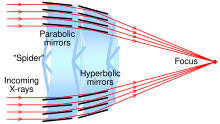In geometric optics, the angle of incidence is the angle between a ray incident on a surface and the line perpendicular to the surface at the point of incidence, called the normal. The ray can be formed by any wave: optical, acoustic, microwave, X-ray and so on. In the figure below, the line representing a ray makes an angle θ with the normal (dotted line). The angle of incidence at which light is first totally internally reflected is known as the critical angle. The angle of reflection and angle of refraction are other angles related to beams.
Определение угла отражения относительно плоской поверхности тривиально, но вычисление почти для любой другой поверхности значительно сложнее. Точное решение для сферы (которая имеет важные приложения в астрономии и компьютерной графике ) рассматривается в проблеме Альхазена .
Угол скольжения [ править ]
When dealing with a beam that is nearly parallel to a surface, it is sometimes more useful to refer to the angle between the beam and the surface, rather than that between the beam and the surface normal, in other words 90° minus the angle of incidence. This small angle is called a glancing angle or grazing angle. Incidence at grazing angles is called "grazing incidence".
Grazing incidence diffraction is used in X-ray spectroscopy and atom optics, where significant reflection can be achieved only at small values of the grazing angle. Ridged mirrors are designed for reflection of atoms coming at small grazing angle. This angle is usually measured in milliradians. In optics, there is Lloyd's mirror.
See also[edit]
- Effect of sun angle on climate
- Illumination angle
- Phase angle (astronomy)
- Plane of incidence
- Reflection (physics)
- Refraction
- Total internal reflection
Notes[edit]
External links[edit]
- Weisstein, Eric W. "Angle of incidence". MathWorld.
- geometry : rebound on the strip billiards Flash animation

